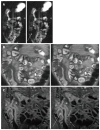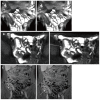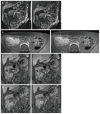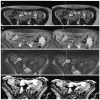Current tecniques and new perpectives research of magnetic resonance enterography in pediatric Crohn's disease
- PMID: 27551337
- PMCID: PMC4965351
- DOI: 10.4329/wjr.v8.i7.668
Current tecniques and new perpectives research of magnetic resonance enterography in pediatric Crohn's disease
Abstract
Crohn's disease affects more than 500000 individuals in the United States, and about 25% of cases are diagnosed during the pediatric period. Imaging of the bowel has undergone dramatic changes in the past two decades. The endoscopy with biopsy is generally considered the diagnostic reference standard, this combination can evaluates only the mucosa, not inflammation or fibrosis in the mucosa. Actually, the only modalities that can visualize submucosal tissues throughout the small bowel are the computed tomography (CT) enterography (CTE) with the magnetic resonance enterography (MRE). CT generally is highly utilized, but there is growing concern over ionizing radiation and cancer risk; it is a very important aspect to keep in consideration in pediatric patients. In contrast to CTE, MRE does not subject patients to ionizing radiation and can be used to detect detailed morphologic information and functional data of bowel disease, to monitor the effects of medical therapy more accurately, to detect residual active disease even in patients showing apparent clinical resolution and to guide treatment more accurately.
Keywords: Crohn’s disease; Enterography; Imaging; Magnetic resonance imaging; Pediatric.
Figures








Similar articles
-
Is the Mixed Use of Magnetic Resonance Enterography and Computed Tomography Enterography Adequate for Routine Periodic Follow-Up of Bowel Inflammation in Patients with Crohn's Disease?Korean J Radiol. 2022 Jan;23(1):30-41. doi: 10.3348/kjr.2021.0072. Epub 2021 Sep 13. Korean J Radiol. 2022. PMID: 34564963 Free PMC article.
-
Main Imaging Features of Crohn's Disease: Agreement between MR-Enterography and CT-Enterography.Isr Med Assoc J. 2015 May;17(5):293-7. Isr Med Assoc J. 2015. PMID: 26137655
-
Prospective comparison of diffusion-weighted magnetic resonance enterography and contrast enhanced computed tomography enterography for the detection of ileocolonic Crohn's disease.J Gastroenterol Hepatol. 2020 Jul;35(7):1136-1142. doi: 10.1111/jgh.14945. Epub 2019 Dec 17. J Gastroenterol Hepatol. 2020. PMID: 31785602
-
Computed Tomography and Magnetic Resonance Enterography: From Protocols to Diagnosis.Diagnostics (Basel). 2024 Nov 18;14(22):2584. doi: 10.3390/diagnostics14222584. Diagnostics (Basel). 2024. PMID: 39594251 Free PMC article. Review.
-
Magnetic resonance enterography for the evaluation of the deep small intestine in Crohn's disease.Intest Res. 2016 Apr;14(2):120-6. doi: 10.5217/ir.2016.14.2.120. Epub 2016 Apr 27. Intest Res. 2016. PMID: 27175112 Free PMC article. Review.
Cited by
-
Indian guidelines on imaging of the small intestine in Crohn's disease: A joint Indian Society of Gastroenterology and Indian Radiology and Imaging Association consensus statement.Indian J Radiol Imaging. 2019 Apr-Jun;29(2):111-132. doi: 10.4103/ijri.IJRI_153_18. Indian J Radiol Imaging. 2019. PMID: 31367083 Free PMC article.
-
Imaging of the small intestine in Crohn's disease: Joint position statement of the Indian Society of Gastroenterology and Indian Radiological and Imaging Association.Indian J Gastroenterol. 2017 Nov;36(6):487-508. doi: 10.1007/s12664-017-0804-y. Epub 2018 Jan 6. Indian J Gastroenterol. 2017. PMID: 29307029
-
Autoinflammatory diseases in childhood, part 2: polygenic syndromes.Pediatr Radiol. 2020 Mar;50(3):431-444. doi: 10.1007/s00247-019-04544-9. Epub 2020 Feb 17. Pediatr Radiol. 2020. PMID: 32065273
-
Utility of FDG PET/CT in assessing bowel inflammation.Am J Nucl Med Mol Imaging. 2021 Aug 15;11(4):271-279. eCollection 2021. Am J Nucl Med Mol Imaging. 2021. PMID: 34513280 Free PMC article.
-
Comparison of patients' tolerance between computed tomography enterography and double-balloon enteroscopy.Patient Prefer Adherence. 2017 Oct 16;11:1755-1766. doi: 10.2147/PPA.S145562. eCollection 2017. Patient Prefer Adherence. 2017. PMID: 29081651 Free PMC article.
References
-
- Malaty HM, Fan X, Opekun AR, Thibodeaux C, Ferry GD. Rising incidence of inflammatory bowel disease among children: a 12-year study. J Pediatr Gastroenterol Nutr. 2010;50:27–31. - PubMed
-
- Mollard BJ, Smith EA, Dillman JR. Pediatric MR enterography: technique and approach to interpretation-how we do it. Radiology. 2015;274:29–43. - PubMed
Publication types
LinkOut - more resources
Full Text Sources
Other Literature Sources
Miscellaneous

